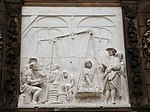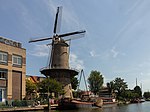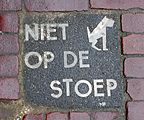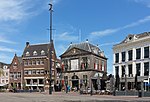Gouda (Netherlands)
 flag |
 coat of arms |
| province |
|
| mayor | Pieter Verhoeve ( SGP ) |
| Seat of the municipality | Gouda cheese |
|
Area - land - water |
18.11 km 2 16.82 km 2 1.29 km 2 |
| CBS code | 0513 |
| Residents | 73,193 (Jan 31, 2019) |
| Population density | 4042 inhabitants / km 2 |
| Coordinates | 52 ° 1 ' N , 4 ° 43' E |
| Important traffic route |
|
| prefix | 0182 |
| Postcodes | 2801-2809 |
| Website | Homepage of Gouda |
| View of the city center and the central town hall on the market square and the Sint Janskerk | |
Gouda ( [ˈɣʌu̯daˑ] , ) is a city and municipality in the western Netherlands in the province of South Holland at the confluence of the Gouwe and Hollandse IJssel . It is located in the Groene Hart of the Randstad agglomeration and counted 73,193 inhabitants on January 31, 2019 on an area of 16.92 km².
Gouda received city rights from the Dutch Count Florens V in 1272 and is traditionally world-famous for Gouda cheese , which was not produced in the eponymous city but in the surrounding area, but was traded from Gouda. In the summer there is a cheese market on the market square every Thursday until today.
Other well-known products from Gouda are tobacco pipes , candles and syrup waffles . In earlier times the city had a flourishing brewing industry ; by the 20th century numerous ceramic manufacturers had settled there. A nationally known event is the annual pre-Christmas event Gouda bij Kaarslicht (Gouda in candlelight), popularly known as Kaarsjesavond (candle evening).
geography
Geographical location and traffic
The city is located in the fertile polder area at the confluence of the Dutch IJssel and Gouwe, not far from the cities of The Hague , Rotterdam and Utrecht , but in the middle of rural Groene Hart .
Together with Alphen aan den Rijn , Bergambacht , Bodegraven-Reeuwijk , Boskoop , Nieuwkoop , Rijnwoude , Schoonhoven , Vlist and Waddinxveen , it forms the COROP region Oost-Zuid-Holland .
Gouda is connected to the A12 motorway and has two train stations with The Hague, Rotterdam and Utrecht: Gouda train station and Gouda Goverwelle train station .
geology
Gouda's inner city area lies on loamy soil, a large part of the rest of the area on soft peatland . These soft soils mean that parts of the city are regularly threatened by subsidence. The necessary countermeasures put such a heavy financial strain on the city that it was one of the so-called Article 12 communities for almost 40 years . In 2001, the city received around 80 million euros in financial compensation, which has been completely suspended since 2008.
Neighboring communities
In the northwest is Waddinxveen, in the northeast is Bodegraven-Reeuwijk. Ouderkerk borders the city in the south, Zuidplas in the south-west and Vlist in the south-east.
City structure
The municipality of Gouda is divided into nine districts:
- Binnenstad (inner city)
- Korte Akkeren
- Westergouwe
- Stolwijkersluis
- Kort Haarlem
- Goverwelle
- North
- Plaswijck
- Bloemendaal
Surname
The Latin name golda was often used in early documents . Other names of the city were Die Golda , Ter Goude and Tergouw , all of which refer to the location on the Gouwe. Tergouw in particular (also spelled Ter Gou or Ter Gouw) is still colloquially the common name of the inhabitants for their city, also to distinguish the city from the region. On the historical "Vogelvluchtkaart van Gouda en omstreken" (Gouda and its surroundings from a bird's eye view) from 1525, the city is referred to as Ter Gou .
A common nickname for the city is “Kaasstad” (cheese town); A nickname for the residents that is often used by the Dutch is Kaaskoppen (cheese heads), which they have to share with the residents of Alkmaar , who are also known for their cheese production.
history
founding
Around 1000 the construction of dams and drainage of the marshland around Gouda began. The area was first mentioned in 1139 in a document from Bishop Hartbert of Utrecht , which mentions the reclamation of the Gouwe.
Around 1225 the river Gouwe was connected to the Old Rhine by a canal . The confluence of the Gouwe in the Dutch IJssel was developed into a port. Now the place was on an important trade route that connected Flanders and the Netherlands with France on the one hand and the Baltic States on the other.
13th to 17th centuries
When Gouda received city rights from Count Floris V of Holland in 1272, it quickly developed into an important trading center. Large city fires raged in 1361 and 1438. In 1572 the city was occupied, plundered and partially burned down by the Wassergeusen . From 1602 raged in Gouda, as elsewhere in the Netherlands, plague ; Only around 1750 did the population recover from this. Nevertheless, the city played an important role nationally and internationally until its decline in the 17th century.
18th century to modern times
After the decline of the cloth industry, the city and its surroundings concentrated on cheese production and the manufacture of pipes, which made it an important economic center again with the beginning of industrialization.
From 1830 the city wall was razed to make room for further growth. The last gate was demolished in 1854.
In 1855 the Gouda – Utrecht railway line went into operation. In 1944 the station was destroyed by Allied bombardments , eight dead and ten wounded.
The asteroid (27718) Gouda has been named after the city since 2017 .
City arms
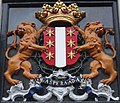
|

|
| Coat of arms and flag of Gouda | |
The coat of arms, officially established on July 24, 1816 by the Hoge raad van de Adel, shows a red shield with three six-pointed golden stars and a white pole , which is covered by a five-pointed golden crown and held by a pair of lions standing upright. The city has the motto: per aspera ad astra , in German: "Through rough air (you climb up) to the stars".
The blazon reads:
- “Van keel loaded with a pal van zilver en verzeld ter neitherzijde van 3 zespuntige sterren van goud, staande in the zin van den pal. Het shield covered with a crown with 5 fleurons, everything van goud en omgeven van eene doornenkrans, voorts vastgehouden door 2 klimmende leeuwen in hunne natuurlijke use en on the hetzelve het oude motto Per Aspera ad Astra . "
The city flag is red-white-red.
statistics
On December 31, 2010, Gouda had 71,073 inhabitants in around 30,000 households. The urban area covers 1,811 hectares, which results in a population density of 40 inhabitants per hectare.
Culture and sights
Attractions
- The town house in the middle of the market square is one of the oldest Gothic town halls in the Netherlands. It was built from natural stone between 1448 and 1450 after the last great city fire. The Renaissance style staircase dates from 1603. Around 1692 and 1880 renovations were carried out. The last restoration took place in 1996. The front painting from 1952 shows Burgundian nobles, and the carillon with mechanical knights on horses comes from the same year. The interior is from the 17th and 18th centuries. The wedding hall has paneling. Every year in mid-December there is a candle festival evening, when the town hall is lit with over 2500 candles.
- The Weaghaus , located on the north side of the market, was built in 1668 by Pieter Post , one of the most important architects of this era. A relief on this building shows how cheese was weighed in the past.
- The Sint Janskerk ( German Saint John Church ) is located southeast of the market square and is the longest cruciform church in the Netherlands with a length of 123 m. It has stained glass windows known as Goudse Glazen in Dutch . 14 of 70 windows from the period between 1530 and 1603 come from the brothers Dirck Crabeth (around 1505–1574) and Wouter Crabeth (1520–1589), who created them between 1555 and 1577. At that time they were considered the best and most famous glass painters in the region. Even after the Reformation , more windows were added, but with different themes. Donors included Prince Wilhelm I of Orange-Nassau and his wife Anna of Saxony, as well as his arch enemy Philip II and his wife Mary Tudor , the Bloody Mary .
Museums
- Gouda Museum
- Cheese and handicraft museum in the Waaghaus
- Resistance Museum South Holland
Ceramics
Up until the 20th century there were numerous large and small ceramic factories ("Plateel Zuidholland", "Regina", "Ivora" and "Zenith") in the city area. Most of them closed in the mid-1930s, a few tried to regain a foothold after the Second World War , with the last and largest (Plateel Zuid Holland) finally insolvent and ceasing to exist in the mid-1960s. The Art Deco and Art Nouveau everyday objects from these manufactories are now sought-after antiques.
gallery
politics
Distribution of seats in the municipal council
The local elections on March 21, 2018 resulted in the following distribution of seats:
| Political party | Seats | |||
|---|---|---|---|---|
| 2006 | 2010 | 2014 | 2018 | |
| D66 | 2 | 3 | 6th | 4th |
| ChristenUnie | 3 | 3 | 4th | 4th |
| PvdA | 10 | 7th | 5 | 4th |
| VVD | 4th | 5 | 3 | 4th |
| CDA | 5 | 3 | 3 | 4th |
| Gouda Positief | - | 3 | - a | 3 |
| GroenLinks | 3 | 3 | 2 | 3 |
| Gouda's 50+ partij | 3 | 2 | 2 | 3 |
| SGP | 1 | 1 | 2 | 2 |
| Community affairs Gouda | 2 | 1 | 5 a | 2 |
| SP | 2 | 1 | 2 | 1 |
| PvdD | - | - | 1 | 1 |
| Jezus Leeft | - | - | - | 0 |
| DEAD | - | 3 | 0 | - |
| Ouderen Politiek Actief | - | - | 0 | - |
| total | 35 | 35 | 35 | 35 |
mayor
Pieter Verhoeve ( SGP ) has been the acting mayor of the municipality since November 13, 2019 . His colleagues include Thierry van Vugt ( D66 ), Rogier Tetteroo ( PvdA ), Jan de Laat ( Gouda Positief ), Corine Dijkstra ( ChristenUnie ), Jan-Willem van Gelder ( CDA ), Hilde Niezen ( GroenLinks ) and the community secretary Martiene Branderhorst .
Twin cities
Gouda has three official international twin cities:
-
 Kongsberg in Norway , since 1956
Kongsberg in Norway , since 1956 -
 Solingen in Germany , since 1957
Solingen in Germany , since 1957 -
 Gloucester in the United Kingdom , since 1972
Gloucester in the United Kingdom , since 1972
Accordingly, there is a Kongsbergstraat , a Solingenstraat and a Gloucesterstraat in the city . The Christmas tree for the market square has been donated by the Kongsberg community since 1956.
In addition, Gouda has had close unofficial relationships with Elmina in Ghana since 2004 , which came about through a Dutch aid project run by the Vereniging van Nederlandse Gemeenten . The aid is mainly focused on tackling the waste problem in the West African city. There is also a partnership relationship with Finsterwalde in Germany.
Personalities
Born in Gouda
- Dirck Crabeth (≈1505–1574), glass painter
- Wouter Crabeth (≈1520–1589), glass painter
- Cornelius Schonaeus (1540–1611), educator and author of neo-Latin comedies and biblical dramas
- Jakob Willemsz. Delff (≈1550–1601), painter and engraver
- Cornelis de Houtman (1565-1599), researcher
- Frederick de Houtman (1571–1627), navigator, researcher and administrator
- Hieronymus van Beverningh (1614–1690), statesman
- Gerard Leeu (between 1445 and 1450–1492), printer
- Cornelis Ketel (1548–1616), painter and sculptor
- Pieter Pourbus (1523–1584), Renaissance painter
- Wouter Pietersz. II. Crabeth (≈1593–1644), painter
- Florens Schoonhoven (1594–1648), lawyer and poet
- Adriaan Vlacq (1600–1667), bookseller and mathematician
- Jan den Haen (1630–1676), Vice-Admiral
- Nicolas Hartsoeker (1656–1725), biologist, mathematician and physicist
- Jan Bleuland (1756–1838), medic
- Jan Willem van Borselen (1825-1892), painter
- Gerard Keller (1829–1899), writer and newspaper editor
- Hermanus Frederik Roll (1867–1935), doctor
- Cornelis Gerrit Nicolaas de Vooys (1873–1955), Dutch artist
- Gerard Abraham van Rijnberk (1874–1953), physiologist
- Jan Gonda (1905–1991), orientalist and religious scholar
- Leo Vroman (1915–2014), Dutch-American hematologist, draftsman and writer
- Ferry Hoogendijk (1933–2014), political scientist, journalist and politician
- Dick van Dijk (1946–1997), football player
- Ad Melkert (* 1956), politician
- Peter Gelderblom (* 1965), DJ
- Rozalie Hirs (* 1965), composer and poet
- Ed de Goey (born 1966), football player
- Andrea Nuyt (* 1974), speed skater
- Max Backer (* 1976), beach volleyball player
- Ingrid Louise Visser (1977-2013), volleyball player
- Simon van der Geest (* 1978), writer
- Dicky Palyama (* 1978), badminton player
- Koen de Kort (* 1982), racing cyclist
- Hind Laroussi (* 1984), singer
- Monique van der Vorst (* 1984), Paralympic athlete
- Verona van de Leur (* 1985), artistic gymnast
- Iris Slappendel (* 1985), racing cyclist and graphic designer
- Flore Gravesteijn (* 1987), volleyball player
- Hein Otterspeer (* 1988), speed skater
- Elisabeth Hogerwerf (* 1989), rower
- Maureen Koster (* 1992), track and field athlete
- Femke Pluim (* 1994), pole vaulter
- Sven van Beek (* 1994), football player
- Joy Stubbe (* 1997), beach volleyball player
Wrought in Gouda
- The humanist Desiderius Erasmus (probably 1466/1467 / 1469–1536) attended the Latin school in Gouda.
- Dirck Volkertszoon Coornhert (1522–1590), poet, scholar and politician, spent the last years of his life in Gouda, where he died in 1590.
- Jasper Tournay (around 1560–1635), printer
- Maaike Ouboter (* 1992), singer-songwriter; grew up in Gouda
literature
- PHAM Abels (Ed.): Duizend jaar Gouda: een Stadsgeschiedenis . Uitgeverij Verloren, 2002. ISBN 90-6550-717-5
- Nicolaas Godfried Kampen, William Gray Fearnside, William Henry Bartlett: The history and topography of Holland and Belgium. G. Virtue Verlag, 1837. Full text available online.
- Phyllis Tater Ritvo, Gene Ritvo: The world of Gouda pottery. Font & Center Press, 1998. ISBN 1-883280-11-7
Web links
- Official website of the municipality (Dutch)
- The Goude Historical Association website (Dutch)
- Gouda tourist information website (German, Dutch, English, French)
Individual evidence
- ^ A b Nieuwe burgemeester van Gouda Pieter Verhoeve beëdigd. In: omroepwest.nl. Omroep West, November 13, 2019, accessed November 15, 2019 (Dutch).
- ↑ Bevolkingsontwikkeling; regio per maand . In: StatLine . Centraal Bureau voor de Statistiek (Dutch)
- ↑ For station Gouda Goverwelle see the list of new train stations in the Netherlands .
- ↑ A Dutch municipality that falls under the so-called Article 12 status is placed under state administration because of its poor financial situation. The name is derived from the Dutch Financiële-verhoudingswet (Law on Financial Relations) of 1897, which regulates the basic distribution of state financial allocations to the subordinate local authorities. Article 12 in particular deals with financial equalization and establishes a close legal and economic relationship with the central government of the municipalities.
- ↑ "nove culture juxta Goldam" in: Samuel Muller, Klaas Heeringa: Oorkondenboek van het sticht Utrecht dead 1301 . Vol. IA Oosthoek Verlag, 1959.
- ↑ http://www.ngw.nl/heraldrywiki/index.php?title=Gouda
- ^ Museum Gouda. In: Gouda Tourist Office website. Retrieved April 4, 2018 .
- ↑ Official website of the Gouda Museum (Dutch)
- ^ Goudse Waag (Waaghaus) Cheese and Craft Museum. In: Gouda Tourist Office website. Retrieved April 4, 2018 .
- ↑ Official website of the Gouda Cheese and Craft Museum (Dutch)
- ^ Resistance Museum South Holland. (No longer available online.) In: Gouda Tourist Office website. Archived from the original on April 5, 2018 ; accessed on April 4, 2018 . Info: The archive link was inserted automatically and has not yet been checked. Please check the original and archive link according to the instructions and then remove this notice.
- ↑ Official website of the Resistance Museum South Holland (Dutch)
- ↑ Result of the local elections: 2014 2018 , accessed on May 31, 2018 (Dutch)
- ↑ Allocation of seats in the municipal council: 2006 2010 2014 2018 , accessed on May 31, 2018 (Dutch)
- ^ College van B en W Gemeente Gouda, accessed on May 31, 2018 (Dutch)









